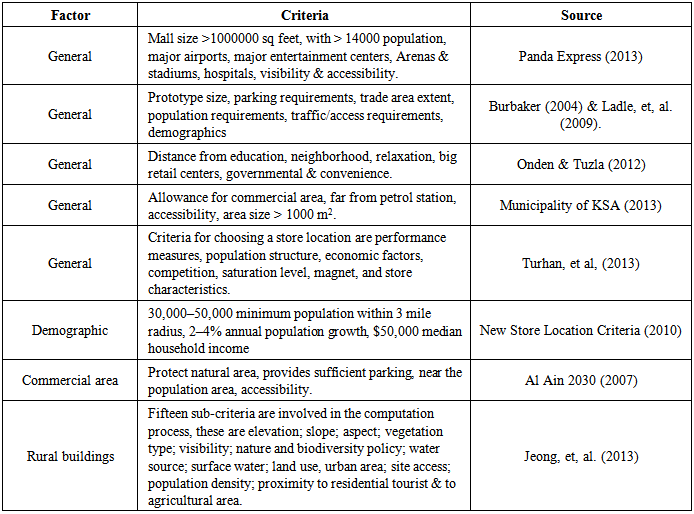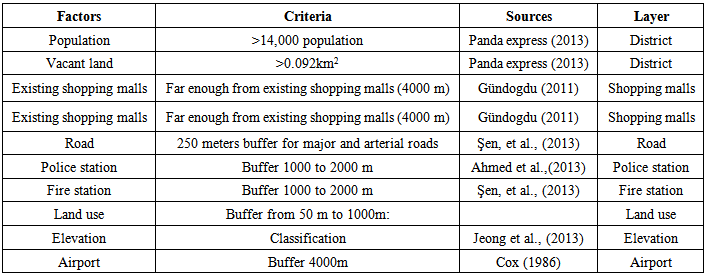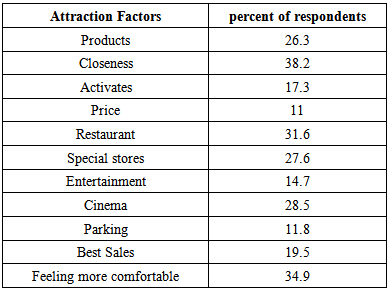-
Paper Information
- Paper Submission
-
Journal Information
- About This Journal
- Editorial Board
- Current Issue
- Archive
- Author Guidelines
- Contact Us
American Journal of Geographic Information System
p-ISSN: 2163-1131 e-ISSN: 2163-114X
2015; 4(2): 76-86
doi:10.5923/j.ajgis.20150402.03
A GIS Application for Location Selection and Customers' Preferences for Shopping Malls in Al Ain City; UAE
Mohamed Y. Mohamad, Fatima Al Katheeri, Abul. Salam
Department of Geography and urban Planning, UAE University, Abu Dhabi, UAE
Correspondence to: Abul. Salam, Department of Geography and urban Planning, UAE University, Abu Dhabi, UAE.
| Email: |  |
Copyright © 2015 Scientific & Academic Publishing. All Rights Reserved.
Geographical Information Systems (GIS) are used today at several planning applications and taking advantage of information technology, this system enable the handling of both spatial and non-spatial data for constructing thematic maps describing a variety of information relating to economic activities. Current research examined the potential of suitable location as well as to study customers' preferences for shopping malls in the area. In this study, evaluation of data concerning the suitable location selection was performed in Geographical information system Arc Info-GIS environment and a number of other criteria were used to evaluate alternative sites, showing four suitable sites for new location of malls. The result shows that the best site choice meeting all the requirements is located in Airport District area. 500 questionnaires were distributed to assess the customer preferences for shopping malls. Even existing in the low population density area, a high percentage of respondents (46%) prefer to shop at Bawadi Mall because it is helpful in servicing large numbers of people and reducing crowds in the city centre. The study concludes that the distribution of shopping malls was generally found to be random and uneven in the city of Al Ain. Therefore, study recommends that there is a need to set the common standards for building malls and carry out more investigation regarding factors such as soil types, land ownership and compensation.
Keywords: GIS, Location selection, Shopping mall, Spatial analysis, Database, Decision analysis
Cite this paper: Mohamed Y. Mohamad, Fatima Al Katheeri, Abul. Salam, A GIS Application for Location Selection and Customers' Preferences for Shopping Malls in Al Ain City; UAE, American Journal of Geographic Information System, Vol. 4 No. 2, 2015, pp. 76-86. doi: 10.5923/j.ajgis.20150402.03.
Article Outline
1. Introduction
- Shopping malls are the most glorious places these days with their attractive shops and a wide variety people where people spend their weekends to relax and shop. With the changing tastes and preferences of customers, shopping malls extend a global impact across metros, cities and towns. Over the last four decades, the UAE has grown exponentially in population, technology and commerce, with Al Ain becoming a major city where people live, work and play. The city of Al Ain has seen population increase from 444,700 in 2005 to 584,800 people in 2011, a growth of 140,100 people this is mainly due to the increase in births and the balance of foreign labour force and this increase generates a changing need for more infrastructures such as schools, hospitals, housing, roads, and malls (Abu Dhabi, 2011).
2. Literature Review and Background
- The increase in the population will cause a demand for easier and quicker access to food, clothing and home products creating an increase in economic business growth. The shopping will rise from small stores to big stores as this increases the need for department stores, which contain many types of products (sporting goods, garden, clothing, market, toy), located within a single building. Therefore, the mall building, which is usually one of the largest in the region, is the ideal way to meet the demand of the shoppers as well as in one building make a shopper friendly environment (Jensen, 2007). Location is one of the land characteristic of high importance for economic analysis. In fact, location is the crucial spatial characteristic on which estimation and analysis of land value can be transformed and create different types of study. Prior to GIS period, the location determinant impact on land values was difficult to be succeeded due to the existing accuracy levels on positioning. Nowadays, GIS offers techniques in tens to facilitate the analytic spatial reasoning (Arbia, 1989; Tomlin, 1990; Huxhold, 1991; Star and Estes, 1990). Location selection is a problem faced by all companies, government agencies, education and public services. Al Ain has distributed shopping malls in last few years depending on some criteria in order to protect the natural reserves such as deserts. In this field of business distribution, centre location selection is a very important issue faced by all the companies.Even though demand for shopping malls are falling in many part of the world. In UK by the mid-1990s, however, the concept of "the mall" had hit its peak. 140 malls were being built a year, creating too much competition, and discount stores as if Marshall’s began popping up, and attracting bargain hunters away from the confines of the mall. Now UK is facing a crisis. The Centre for Retail Research published its analysis of how UK retailing will have changed Retail Futures 2018 forecasts that by 2018 total store numbers will fall by 22 percent, from 281,930 today to 220,000 in 2018 (CRR, 2014).In USA the decline in sales surprised many, who had seen increasingly positive US economic data as well as lower gas prices as signs that the US holiday shopping season would be better than it has been in the past. USA retailers reported that sales falling 11 percent from the same period last year, according to the National Retail Federation (BBC News, 1 December 2014). According to Green Street Advisors, a Real Estate and Analytics Firm (REAF) noted that 15 percent of U.S. malls will fail or be converted into non-retail space within the next 10 years. That is an increase from less than two years ago, when the firm predicted 10 percent of malls would fail or be converted (Hayley, 2015). States hit particularly badly include Texas, Pennsylvania, Ohio, New York, and Illinois, according to Deadmalls.com, which tracks mall closures.Retail has long been among the engines of economic growth in Russia high inflation and more than 20 percent devaluation of the rubble have hit Russian spending power and foreign retailers' profits. Some retailers have already closed down stores such as Empik Media & Fashion closed its Esprit and OVS stores and those that remain are re-evaluating their development plans. Finnish department store Stockmann also announced plans to close 20 of its clothing stores in Russia (D'Amora, 2014). Even though the fall of malls is increasing in many part of the world but the demand of malls in UAE and in particular, in Al Ain city are increasing. Al Ain city witnessed rapid development in the last few years mainly due to revenues from oil and booming in the tourism industry. This development together with high consumers leads to increase in the number of malls.
2.1. Shopping Malls
- Shopping malls are retail properties with special qualities compared to other property investments (Gerbich, 1998). However, it appears the forces driving retail expansion all over the world have deviated from actual consumer demand. A shopping mall is a collection of retail stores. It is usually the largest building complex in the region. The large shopping centres containing cinemas, entertainment areas, restaurant areas, and parking areas called malls combine many small shopping stores under one roof and include various activities. The customers go to shopping malls not just for shopping but for all things such as clothing, housing needs (foods, furniture), educational needs (bookshops), health care (clinic, Pharmacy, beautification), and clubs. Conversely, a mall is a collection of multiple department stores built for earning as much from its customers as possible (Pederson, 2013). The department stores and malls are often located at the junction of major highways and in downtown areas because they are the most populated areas. The development of the emirate be seen as an outcome of a broad range of economic, institutional, political, and cultural factors that function in interaction; that is, this development lends itself to multi-causal explanation (Havidt, 2009). Al Ain has greatly expanded in the last few years creating a need for more malls. A current study done by Mohamed, (2004) using satellite imagery (Landsat TM, SPOT HRV, and IKONOS), to detect the direction of expansion of Al Ain and to monitor the change at regional level show that the city was found to have a tendency for expansion in different directions at different rates. As a result, the direction of Al Ain’s expansion was governed by natural, legal, and political constraints that have compelled the physical form of the city to be stretched over a wide distance in the western and south-western directions along the Al Ain – Abu Dhabi road. This expansion direction may help in allocating of new malls.
2.2. History of Malls in Al Ain City
- Like the United Arab Emirates, Al Ain has grown and changed in many ways; housing, travel and shopping have modernized over the last 42 years. As part of this modernization, Al Ain has opened four shopping malls across the city in ten short years.Al Jimi Mall was the first shopping mall opened in Al Ain City in 2002; it is located in the Al Jimi area close to the governmental buildings. The building originally built as a vegetable and meat market in the early 80’s, but later restored, which earned it an ICSC certificate of merit for innovation in restoration and redevelopment in 2002 (Al Jimi Mall, 2013). This mall becoming the first location where shoppers could purchase a variety of household needs from multiple stores under one roof. Al Ain Mall is Al Ain’s premier shopping and leisure destination opened in early 2001. It has over 175 stores selling everything and became an integral part of Al Ain’s identity and daily life. Al Ain Mall is home to 350 world-renowned shops and hosts more than 12 million visitors a year, 55 percent of which are UAE nationals creating the need for a larger mall and, an extension was added (Al Ain Mall, 2013). Bawadi Mall, in Mazyad area is the largest mall in Al Ain, opened in 2008. It has over 400 shops, representing both international and regional brands. The mall includes a traditional souq called Heritage Village where one can find carpets, animals, plants and trees. Keeping the past in mind, Heritage Village was built using beautiful Islamic architecture (Bawadi Mall, 2013). Bawadi Mall also has a family entertainment area which includes movies, rides, snow tubing and games for all ages. Al Foah Mall is strategically located in Al Ain in the centre of a rapidly developing residential area, opened in 2010. Additionally, it is also easily accessible from Dubai and Abu Dhabi. Al Foah Mall has a food court, outlets, coffee shops, and an entertainment area (Al Foah Mall, 2013).
2.3. Application of Geographic Information System (GIS) for Malls
- Geographical Information Systems (GIS) are used today at several planning applications including land use planning, health care planning, and transportation planning. Site selection is an issue for many different kinds of businesses. Retailers, banks, savings and loans, and health care and service providers of all types face the common issue of placing sites in close proximity to their customers and prospects (GIS for Retail Business, 2013). Geographical Information Systems (GIS) used today to provide advanced analysis tools and complete data packages for analysing retail and demographic information.Public Participation in decision-making processes works not only to identify areas of common values or variability, but also as an illustrative and instructional too (Higgsn et, al 2008). It is necessary to find and evaluate any problems, which may affect the structure; the builder needs to determine a suitable location for the mall to ensure a strong customer base for the retailers. It is observed that urban projects evolve according to their location and huge amount of long term investments. This makes some locations the favourites of capital owners because of their location properties such as a central position in the city or ease of transport with automobile (Yırtıcı, 2005; Ozaydin & Ozgur, 2009; Terzi, et, al.). The Geographic information System (GIS) is a technological method of organizing and arranging the site location of the mall. GIS provides the framework in which all these techniques can be utilized by first looking at what factors contribute to successful site location. Spatial analysis is one of the most important applications of GIS. It is possible to integrate different analyses via, for example, ArcGIS Model Builder tool that allows the combination of data inputs; interactive and dynamic spatial analysis; and resulting outputs (Onden & Tuzla, 2012; Mishra, 2009). Therefore, this study was designed to examine the potential of suitable location as well as to study customers' preferences for shopping malls in the area and to identify new sites for shopping malls. • The study hypothesized that the Al Bateen and Zakhir districts will be ideal locations for new malls based on population density and non-availability of malls in these districts.• It was hypothesized that the Bawadi Mall attracts more customers based on diversity of its stores and entertainments.
2.4. Study Area
- Al Ain city was selected for this study because it is located on the junction of two major trade routes, namely the routes between Abu Dhabi and the mountain pass to the Gulf of Oman and between Dubai and settlements south of Al Ain along the foothills of the Omani mountains (Cox, 1986). Al Ain is the fourth largest city in the United Arab Emirates and the second largest in Abu Dhabi, with a population of 584,800 people in 2011 (Abu Dhabi, 2011). Al Ain is located 155 km east of Abu Dhabi and 140 km southeast of Dubai. This city labelled as the ‘Garden City’ given the many oases, which are surrounded by magnificent red sand dunes that vary in texture UAE (Al Ain An Oasis City, 2001). Al Ain city is located in the Eastern region of the United Arab Emirates between latitude 24° 03' and 24° 22' north and longitude 55° 28' and 55° 53´ east (Barrault, 2013). Al Ain is one of the major tourist destinations in the UAE with crowd drawing attractions like Al Ain National Museum, Jebel Hafeet, Al Ain Oasis, Fun City, many parks as well as the largest and oldest zoo in the Emirates. These tourist destinations attract many foreign tourists from neighbouring Europe and other countries around the world throughout the year. The mega-projects launched in Dubai, Abu Dhabi and Al Ain have considerably increased the European population in all these Emirates with Al Ain housing a large number of western expatriates who have chosen to work and live in the UAE (Al Ain An Oasis City, 2001).
3. Methodology
- GIS integrates geographic and attribute data about population and the methods assessed based on population measures, distance between shopping malls and proximity to the Central Business District (CBD).In term of population density, the districts were classified to identify the density in each district in Al Ain. It was the most commonly used with a simple math formula whereby one takes the total population of a place according to current census data and divides it by the total physical area. PD=N/A -population density= number of organisms/areaPD=N/A, PD stands for population density; N stands for the number of organisms; A stands for the areaActually, there was a relationship between the spatial distribution of objects and population density. Therefore, distribution of shopping malls depended on population density, which was the most important factor for evaluating shopping mall distribution. Many researchers such as Ertekin et al. (2008) used this factor of feature distribution. The total population was analysed to identify the relationship between population density and existing shopping malls and to check whether there is a need for a new mall. Distribution of shopping malls throughout the study area was also an important point that needed to be considered by measuring the distance between shopping malls. The criteria used by Gündogdu (2011), Cheng et al (2007) easily identified the distance between points using distance tools (Euclidean distance) in ArcGIS software. The Euclidean distance tools describe each cell's relationship to a source or a set of sources based on the straight-line distance. It gives the distance from each cell in the raster to the closest source (ArcGIS 10.1).The geographic database included boundaries of districts from which areas, distances from the CBD and distribution of shopping malls from the CBD were calculated. It indicated the ring, which is called the buffer in ArcGIS software, to be from 3 km to 10 km covering areas occupied by the city to see the distribution of shopping malls with population. The buffer distance parameter can be entered as a fixed value or as a field, containing numeric values because the buffer distance is a constant; all features are buffered to the same width.The growing population of urban settings required selection of new shopping malls and selection depends on many factors such as population, road networks, existing shopping malls, land use, available vacant land, elevation, parks, fire and police stations, and airports. Criteria were entered into a model builder to discover suitable locations for shopping malls.This model concentrates on shopping malls and consists of three main processes, which are:• Suitability Modelling Process • Exclusion Modelling Process • Final Modelling Process The criteria of site selection for the new shopping malls have been compiled from many previous researches around the world (Table 1). The researcher had a meeting with the people in Municipality. Specifically with Bakri Abd Al Raheem and Laila Al Rashidi from Al Ain Town Planning (11/11/2013) and asked whether there are standards for establishes mew malls. They mentioned there are no standards for establishing new research ushered part of the world (Table 2).
|
|
|
|
4. Result Analysis
- Excel software version 2010 was used to analyse the survey results for the study, ArcGIS 10.1 was used for spatial analysis, Photoshop was used for graphic finishing, Survey Monkey was used for online survey, and Google Earth to check location of selected site. Following are population measure, distance between shopping malls and proximity to the center business district (CBD) used in our investigation.The population of the central districts of Al Ain in 2010 was 284,736. Of the 34 districts, the largest population number is 41,056 in the Central District, which represented 14 percent of Al Ain. The population is broken down into the number of males and females in each district. The district with the highest population density is Al Jahili with 3820, while the district with the lowest population density is Bida Bint Saud with six residents. 94.4 percent of the districts have more males than females while some are heavily populated with males (Sanaiya, Bida Bint Saud and Airport East, and Al Ain International Airport. Though Al Jahili has the largest population density, the residents are mostly male (69.5 percent). There are a few areas where the ratio is close to 50 percent male and female with Al Maqam being the most evenly divided (330 female and 333 male). Asharej has the highest percentage 68 percent) of females with Al Agabiya being the second highest (63 percent), probably due to the woman's university and the hospital being in the districts.Based on (Mohamed. (2006) research, the increase of population in 2001 was from the CBD toward western direction (see Figure 1) presents the CBD, which is very important to determining the direction of increase of population in Al Ain as the city grows. The mean centre of population was in Central District. The direction of population increase was to the northeast because it has more attraction than the urban areas. In the south, there are industrial areas and conservation zones such as Hafeet Mountain and the zoo that limit boundaries for residential areas. The most suitable location of new malls would be in the north and northeast areas of Al Ain as this is where the population growth is occurring.Distances to the CBD and distribution of shopping malls with the population of districts were not found to be significant (Ertekin et al., 2008). The correlation between population density and malls is positive in the areas that have the highest population density, Al Ain Mall and Al Jimi Mall. Meanwhile two other malls (Al Foah Mall and Bawadi Mall) located in the lowest population density area have negative association (see Figure 1). Although located in lowest population density area, Bawadi has the highest percentage of respondents in the survey.
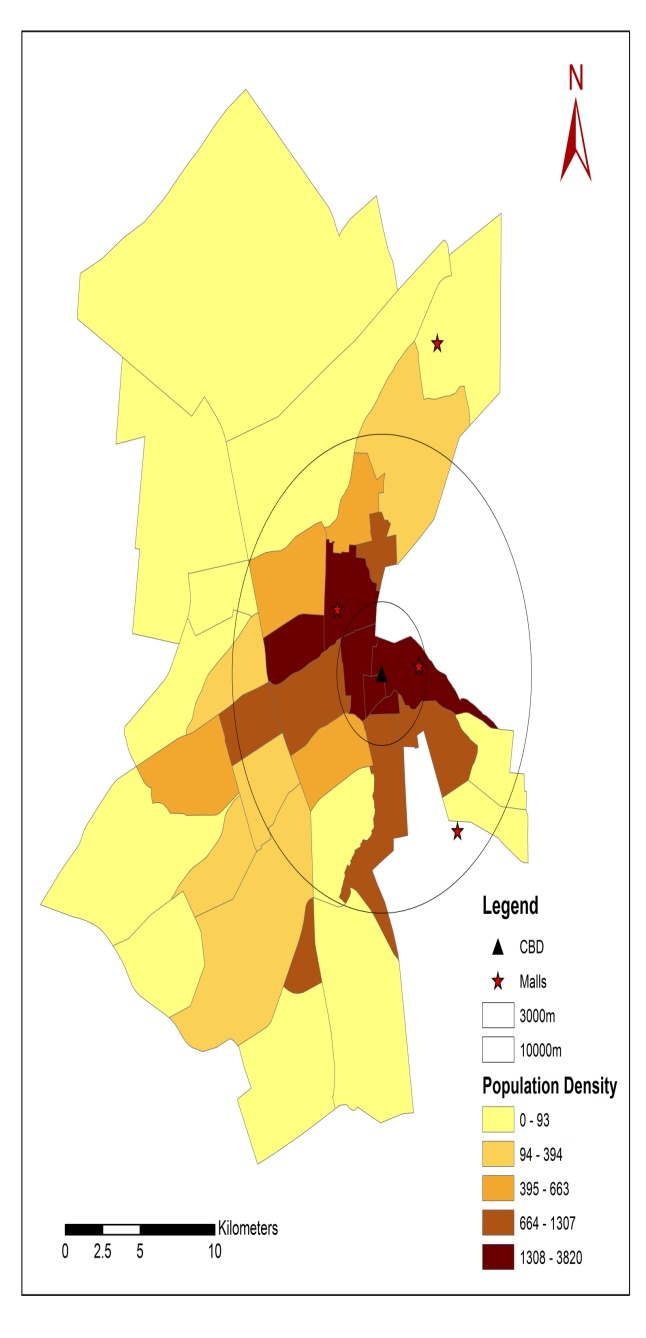 | Figure 1. Al Ain Population Density |
|
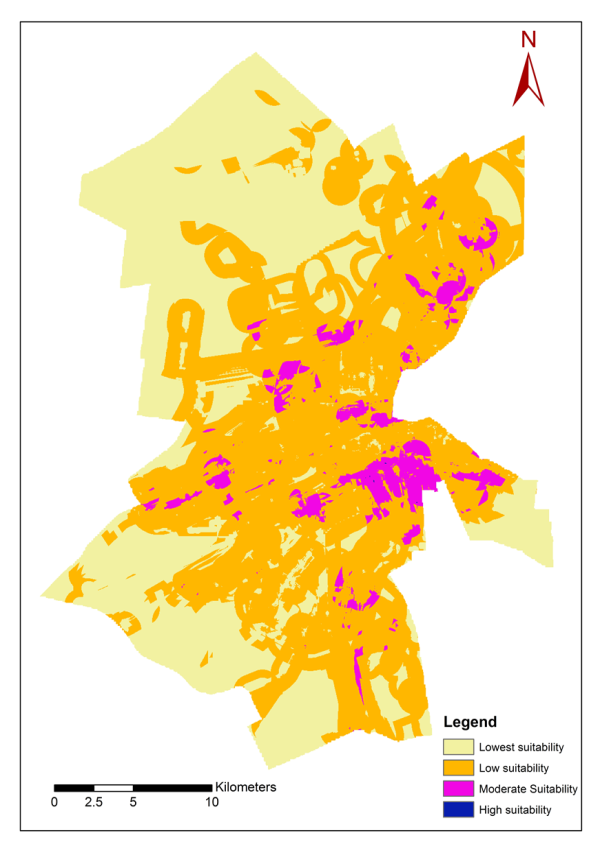 | Figure 2. Suitable locations for new shopping malls |
|
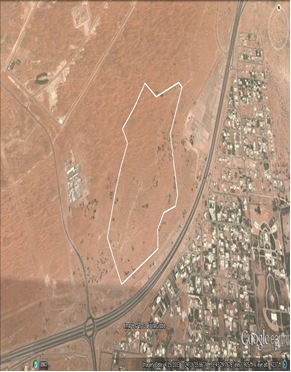 | Figure 3. The Best Site Location of the proposed mall (site 1) |
|
|
|
|
|
5. Conclusions
- GIS method is consider as useful and important analytical tool used to study the distribution of shopping malls in Al Ain city. The application help to identifies new sites for shopping malls, geographical distribution of customer and generation of maps for customers’ preferences of shopping malls. The study found out the large proportion of customer prefers to visit some malls by using their car, which are far such as Bawadi mall. This may be attributed to available more facilities and indicates improved socio economic status. In addition to that it also indicate that to build a new mall is in the Airport District area and the customers prefer going to there, even if it located far from where they live. In this case, the opening of a shopping center in a consolidated area can hardly become an articulating piece of the urban space. As the investigation reveals, responses from customers indicate the number of shops, size of the area and atmosphere play the most important roles in determining locations for new malls. According to the current study, a random and uneven distribution of shopping malls is found in Al Ain. The study suggests that adding more malls would be a viable salutation and site 1 is area that is more suitable. The study also suggests that carrying out more investigation regarding factors such as soil types, land ownership and compensation. Currently, there are no standards for building malls and it is highly recommended that standards to be set. The result also indicates that the majority of the respondents prefer malls that are entertain to them. Therefore, it is recommended to build mall with large area that can provide various services and entertainment. The public should have an awareness of honesty in their responses and participate in the surveys in order to ensure their preferences are recognized.
ACKNOWLEDGEMENTS
- Authors are grateful to all the people those who helped to make this study a success.
References
| [1] | Abu Dhabi (2011). Population and Demography. Statistical Yearbook of Abu Dhabi 2012, 17 – 15. |
| [2] | Jensen, J. R., (2007) Remote Sensing of the Environment an Earth Resource Perspective, Upper Saddle River, NT: Prentice Hall Series in Geographic Information Science. |
| [3] | Arbia, Giuseppe. (1989). Spatial Data Configuration in Statistical Analysis of Regional Economic and Related Problems. London: Kluwer. |
| [4] | Tomlin, C. Dana. (1990) Geographic Information Systems and Cartographic Modelling. Englewood Cliffs, NJ: Prentice-Hall. |
| [5] | Huxhold, W. E. (1991) An Introduction to Urban Geographic Information Systems, Oxford and New York: Oxford Univ. Press. |
| [6] | Star, J., and Estes, J. (1990) Geographic Information Systems: An Introduction. Englewood Cliffs, NJ: Prentice Hall. |
| [7] | Centre for Retail Research (2014) Retail in 2018 - Shop numbers, Online and the High Street, Blackburn House, Brake Lane, Newark, Notts, NG22 9HQ Retrieved January 14, 2015 from http://www.retailresearch.org/retail2018.php. |
| [8] | BBC News (1 December 2014) Retrieved January 14, 2015 from http://www.bbc.com/news/business-30283768. |
| [9] | Hayley, P. (2015) The Shopping-Mall Crisis Is Getting More Ominous, 2015 Business Insider Inc. NYC. |
| [10] | Delphine d'Amora (2014) The Moscow Time) Empty Stores in Moscow as Falling Ruble, Inflation Take Toll http://www.themoscowtimes.com/business/article/empty-stores-in-moscow-as-falling-ruble-inflation-take-toll/509360.html Retrieved January 14, 2015 from. |
| [11] | Gerbich, M. (1998) Shopping Centre Rentals: An Empirical Analysis of the Retail Tenant Mix. Journal of Real Estate Research, 15(3): 1-10. |
| [12] | Pedersen, S. (2013) The Shopping Mall as A Public Space. Mat.nr. 1 – 9. |
| [13] | Havidt, M. (2009) The Dubai Model: An Outline of Key Development-Process Elements in Dubai. International Journal Middle East Studies, Vol.41 Pp 397–418. Printed in the United States of America doi: 10.1017/S0020743809091120. |
| [14] | Mohamed, Y, M. Monitoring of Urban Growth of a Desert City through Remote Sensing: Al-Ain, UAE, between 1976 and 2000. Int. J. Remote Sensing, 25(6), 1063 – 1076 (2004). |
| [15] | Al Jimi Mall (2013). Retrieved November 14, 2013, http://www.aljimimall.com/en/themall/history.php. |
| [16] | Al Ain Mall (2013). Retrieved November 14, 2013, http://www.alainmall.net/2010/about.html. |
| [17] | Bawadi Mall (2013). Retrieved November 14, 2013, from http://www.bawadimall.net/Facts/. |
| [18] | Al Foah Mall (2013). Retrieved November 14, 2013, http://www.alfoahmall.com/about-the-mall.php. |
| [19] | GIS for Retail Business (2007, February). Retrieved September 20, 2013, fromhttp://www.esri.com/library/bestpractices/retail-business.pdf |
| [20] | Higgs, G., Berry, R., Kidner, D, Langford, M. (208) Using IT approaches to promote public participation in renewable energy planning: Prospects and challenges. (2008). Land Use Policy 25, 596-607. |
| [21] | Yırtıcı, H. (2005). The spatial organization of contemporary capitalism. Istanbul: (Bilgi University Press). |
| [22] | Özaydın, G., & Özgür, E. F. (2009) A revaluation on shopping malls as grand scale urban projects in case of Istanbul. Journal of Architecture, 347, 55-69 |
| [23] | Terzi, F., Mutlu, H., & Dokmeci, V. (2006) Retail potential of districts of Istanbul. Journal of Retail and Leisure Property, 5(4), 314-325. |
| [24] | Onden, S. & Tuzla, H. 92012) Evaluation of Retail Store Location Alternatives for Investment Decisions Using the Delphi Technique and Geographic Information Systems. International Business: Research, Teaching and Practice, 2012, 6(2), 64– 76. |
| [25] | Mishra, S. (2009) GIS in Indian Retail Industry-A Strategic Tool. International Journal of Marketing Studies, 1(1), 50 – 57. |
| [26] | Cox, S. (1986) Master Plan for the Region of Al Ain. Emirate of Abu Dhabi Town Planning Department of Al Ain, 1. |
| [27] | Al Ain An Oasis City (2001). Geography & Climate. Al Ain Town Planning, 1ed, viii. |
| [28] | Barrault, M. (2003). Regards Al Ain. Al Ain Economic Development &Tourism Promotion Authority, 48 – 49. |
| [29] | Ertekin, O., Dokmeci, V., Unlukara, T. & Ozus, E. (2008). Spatial Distribution of Shopping Malls and Analysis of their Trade Areas in Istanbul. European Planning Studies, 16(1), 143 – 155. |
| [30] | Gündogdu, C. E. (2011) Suitable Location Selection Optimization for Shopping Centres and Geographical Information System (GIS). China-USA Business Review, 10 (8), 711-718. |
| [31] | Panda Express (2013).http://www.pandaexpress.com/files/PandaExpressSiteCriteria.pdf (Accessed October 10, 2013). |
| [32] | Burbaker, B. T. (2004). Site Selection Criteria in Community Shopping Centres: Implications for Real Estate Developers. Brigham Young University, 2001, 1 – 61. |
| [33] | Ladle, J. K., David, A. & Duane, S. (2009) Retail Site Selection: A New, Innovative Model for Retail Development. Cornell Real Estate Review, 7, pp 1– 26. |
| [34] | Ministry of Municipal Affairs KSA (2013) VIEW PDF FILE (Retrieved October 27, 2013). |
| [35] | Turhan, G., Akalın, M. & Cemal, Z. (2013) Literature Review on Selection Criteria of Store Location Based on Performance Measures. Paper presented at the Proceedings of the 9th International Strategic Management Conference, 405 - 414. |
| [36] | New Store Location Criteria (2013)http://www.firestonecompleteautocare.com/realestate/new-store-criteria (Retrieved November 10, 2013). |
| [37] | Al Ain 2030 (2007). Urban Structure Framework Plan Abu Dhabi Urban Planning Council, 5–61. |
| [38] | Jeong, J. S., Moruno, L. G. & Blanco, H. J. (2013) A Site Planning Approach for Rural Buildings into A Landscape Using A Spatial Multi-Criteria Decision Analysis Methodology. Land Use Policy, 32, pp 108 – 118. |
| [39] | Şen, A., Önden, I., Gökgöz, T. & Şen, C. (2013) A GIS Approach to Fire Station Location Selection. http://www.academia.edu/2500104/ (Accessed February 21, 2013). |
| [40] | Ahmed, A., Muhammad, N., Mohammed, M. U. & Idris, Y. (2013). GIS-Based Analysis Police Stations Distributions in Kano Metropolis. IOSR Journal of Computer of Engineering, 8(4), PP 72-78. |
| [41] | Oh, H., Fiore, A. M., & Jeong, M. (2007) Measuring experience economy concepts: tourism Applications. Journal of Travel Research, 46, 119-131. |
| [42] | Johns, R. (2010), Likert Items and Scales. Survey Question Bank: Methods Fact Sheet I 1– 11. |
| [43] | Mohamed. Y., Mohamed. (2006) Geographic Information Systems (GIS) for Business: Customer Distribution in Al Ain. Bulletin of the Egyptian Geographical Society, vol. 79: 49-60. |
| [44] | Tiwari, R. & Abraham, A. (2010) Understanding the Consumer Behaviour towards Shopping Malls in Raipur City. International Journal of Management & Strategy, 1(1). |
| [45] | Survey Monkey (2013).https://www.surveymonkey.com/home/ (Accessed October 26 2013). |
 Abstract
Abstract Reference
Reference Full-Text PDF
Full-Text PDF Full-text HTML
Full-text HTML